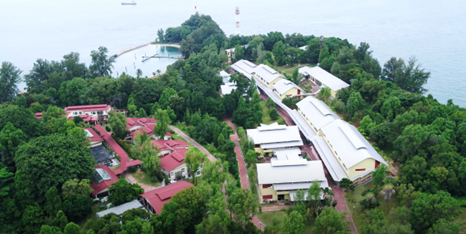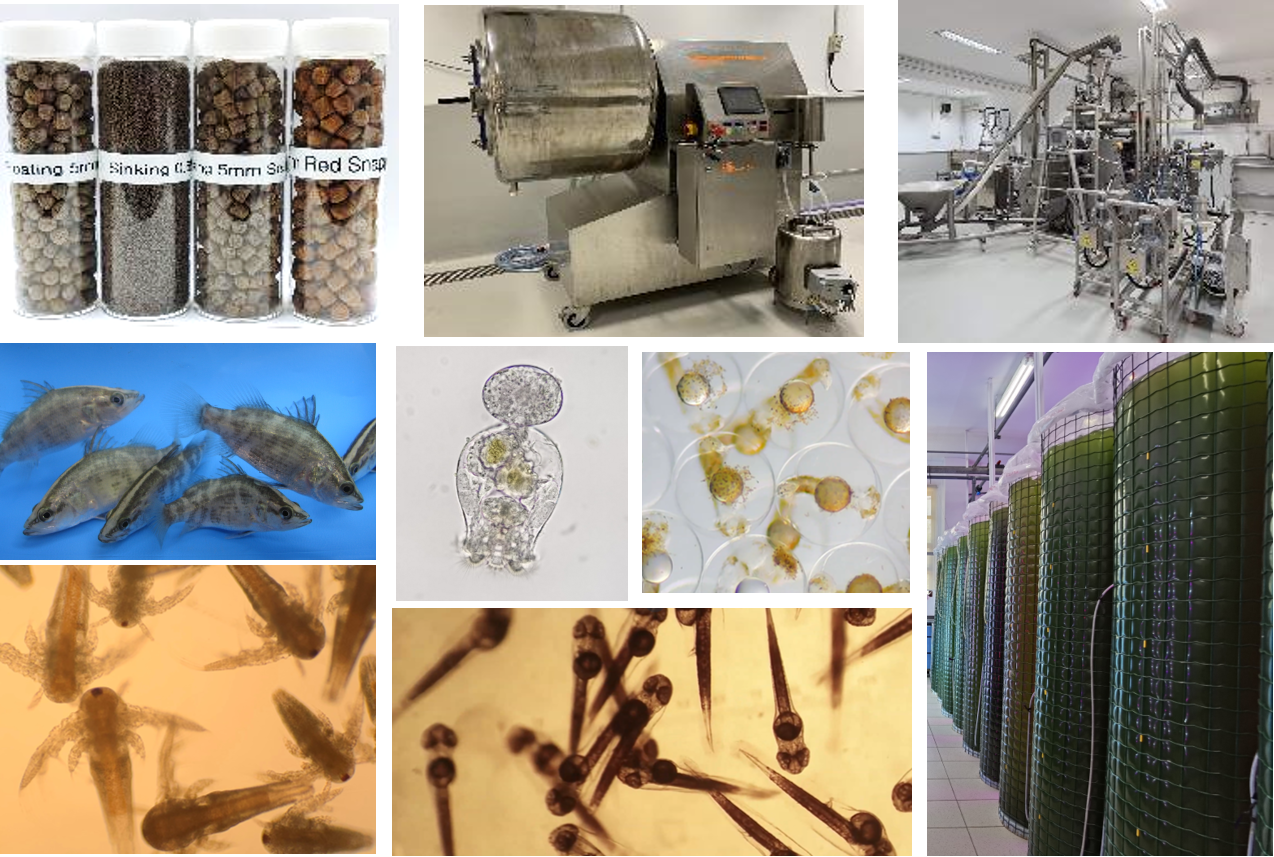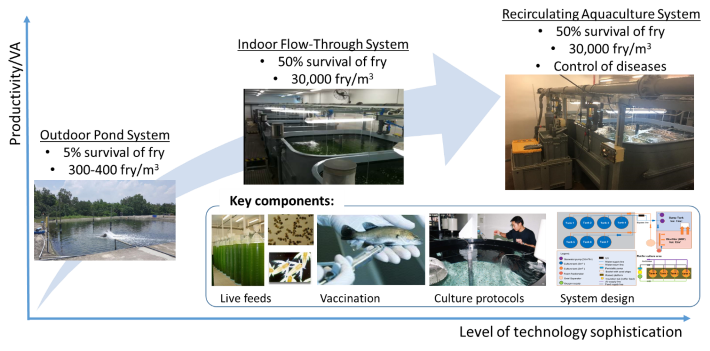Contents in this page
The Singapore Food Agency Marine Aquaculture Centre

The Marine Aquaculture Centre (MAC) is located on St John's Island in the open southern waters of Singapore.
As the R&D hub for tropical marine aquaculture, the Marine Aquaculture Centre (MAC) plays a crucial role in Singapore's ‘30 by 30’ vision.
Marine Aquaculture Centre
MAC enables the aquaculture industry to grow more with less in resource-scarce Singapore by deepening our expertise and building up our R&D ecosystem in tropical marine aquaculture through partnerships with the industry and academia.
For instance, MAC conducts R&D on large-scale hatchery production technology and fish nutrition (e.g. fish feed) which are more nutritious and, at the same time, environmentally sustainable.
Local hatcheries like Singapore Aquaculture Technologies (SAT) and Aquaculture Centre of Excellence (ACE) have since adopted MAC’s live-feed production and hatchery protocols for their fry production.
MAC's Research Activities

The Centre has 14 purpose-built blocks that house specialized research facilities, incubation modules, and essential auxiliary structures for aquaculture research.
In addition to R&D led by SFA officers, MAC also partners research groups from various research institutes (like Temasek Life Sciences Laboratory and Tropical Futures Institute) and institutes of higher learning in Singapore (such as polytechnics, the National University of Singapore, and Nanyang Technological University) to drive innovation and conduct cutting-edge tropical marine aquaculture research.
MAC also provides space for aqua-tech companies to test-bed their technology to enhance tropical marine aquaculture practices.
These activities allow MAC to drive innovation in the field of aquaculture.
MAC’s Expertise and Facilities
MAC supports local R&D efforts with its expertise in crucial areas of fish husbandry such as breeding, live feed, hatchery production, and fish diet formulations.
Local researchers have access to facilities purpose-built for aquaculture research at the MAC. They include replicated tank systems and incubator spaces, which are ideal for the commercial test-bedding of R&D outcomes.

Experimental tank systems of different tank volume for fish trial.
Local researchers also have access to key aquaculture research and feed production resources, including eggs, larvae, rotifers, and microalgae.

Clockwise from top left: On-site fish feed production, vacuum coater, twin screw extruder, microalgae, seabass larva, Artemia nauplii, seabass fingerlings, rotifer, seabass egg.
MAC’s Key R&D Collaborations
Faster-growing Asian seabass through selective breeding

Asian seabass brooders kept at MAC. Brooder are fish chosen for producing offspring. These brooders are selectively bred for faster growth, have better resistance to diseases, and improve nutritional value. Their offspring inherit these desirable traits and qualities.
MAC collaborated with Temasek Life Sciences Laboratory (TLL) to develop the Asian seabass selective breeding programme, where brood stock (fish selected specifically for breeding) was meticulously selected using aquaculture genomic tools.
The genomic tools identified fish with desirable traits for breeding, such as fishes with a faster growth rate, higher disease resistance, and higher omega-3 fatty acid content.
The brood stock produced offspring that inherited these traits. The process was then repeated, with subsequent generations inheriting and accentuating the desirable traits.
As a result, the Asian seabass selective breeding programme gradually produced a lineage of fish with accelerated growth, increased disease resistance, and higher levels of omega-3 fatty acids, without the use of genetic modification.
These fast-growing, disease-resistant fingerlings have higher survival rates, increasing farm yields and giving local fish farmers a productivity boost.
When our local farms produce more to meet our food needs, Singapore becomes more food resilient and takes a step closer to achieving our ‘30 by 30’ vision.
Transformation of outdoor ponds to large-scale indoor hatcheries
Another R&D challenge MAC undertook was to expand local fish production capacity without constructing additional outdoor ponds.
Outdoor ponds require substantial land and are exposed to external elements that may disrupt production, such as extreme weather conditions and algae blooms. In Singapore, where land is scarce, R&D breakthroughs to grow more with less are needed to expand the capacity and capability of our local aquaculture industry.

An indoor hatchery featuring a Recirculating Aquaculture System (RAS), designed to improve productivity and minimise environmental impact.

MAC conducts hatchery R&D that leads to technology and sustainable farming practices that local fish farms can adopt to increase their production yield and quality.
MAC embarked on research to transform local hatcheries from large outdoor pond culture to intensive, high-capacity indoor hatcheries for Asian seabass, occupying only a fraction of the physical size.
The result was an intensive indoor hatchery that features a Recirculating Aquaculture System (RAS) – a technology that local fish farmers can adopt for indoor, large-scale, closed-loopfish production.
In closed-loop systems, all resources are recycled. For instance, the RAS recycles the water by treating and recirculating it. This reduces the need for large amount of water and minimises waste discharge at the same time.
The constant supply of clean water, combined with the contained indoor environment, ensures the fish are not exposed to harmful elements and can grow in a stable, controlled environment.
With this technology, fish farmers can potentially achieve improved Asian seabass fry survival and significant intensification over outdoor pond systems.
The experience gained from this effort has since been successfully transferred to hatchery protocols for other key marine fish species such as snapper, pompano and grouper. This technology is a game-changer for Singapore’s aquaculture sector. It not only resolves space limitations but also offers better bio-security measures to minimise diseases and waste discharge.
Optimising feed that is great for fish and good for the environment
In the world of aquaculture, fish feed plays a pivotal role. A good fish feed ensures that fishes receive the right balance of nutrients, e.g., vitamins and minerals to maximise its health and growth while reducing the environmental impact of fish farming.

The Aquaculture Nutrition Facility is purpose-built for research into fish feed nutrition.
To encourage research in fish feed nutrition, MAC set up the Aquaculture Nutrition Facility to explore more sustainable ingredients for feeds, increase the digestibility of feed by fishes, thereby reducing waste and increasing environmental sustainability. The Pilot Feed Mill and Experimental Tank Systems at the facility are specially designed for nutrition studies.
Researchers use the facilities to conduct research, such as developing experimental fish feeds and testing these feeds through fish feeding trials.
These research efforts contribute to the discovery of new knowledge and methods in the area of fish nutrition.
MAC’s support for local farms
Aside from R&D, MAC also provides technical advice to help local farms adopt sustainable farming practices and technology.
This includes advising farms on setting up live feed cultures and hatcheries, developing protocols for hormone injections, and using fish breeding techniques to boost yield.
Farmers can seek these advisory services through the SFA Feedback Form.
Learning Journeys to MAC
While MAC is not available for public tours or walk-in visitors, it offers both customised on-site and virtual learning journeys for schools to inspire young, curious minds to learn more about aquaculture.
| On-site Learning Journeys | Virtual Learning Journeys |
|---|---|
| Only for students studying aquaculture and/or teachers teaching aquaculture/fish biology-related topics. | For students and teachers in secondary school and higher education. |
| Max 20 pax per session | No pax limit per session |
| Preferably on the last Friday of the month | Available every last Friday of the month |
| 2pm – 4pm | 2pm – 4pm |
| To book, apply here | To book, apply here |
Self-paced Learning Journeys for everyone
Those curious about the fascinating world of aquaculture can go on a self-paced virtual learning journey on YouTube from the comfort of your home.
Through the video tour, you can explore the advanced facilities up close and learn about our research projects.
For more information
You can contact us at:
Marine Aquaculture Centre
St John’s Island, Singapore
Tel: (65) 9046 4787
